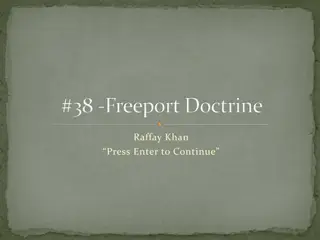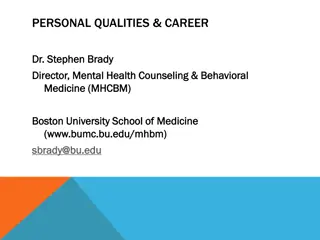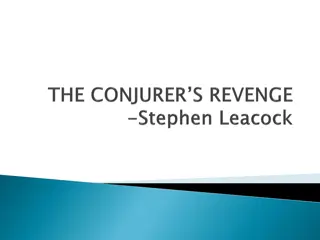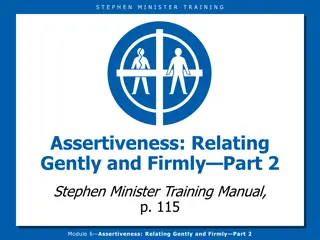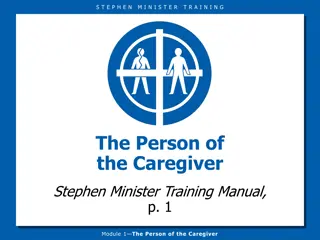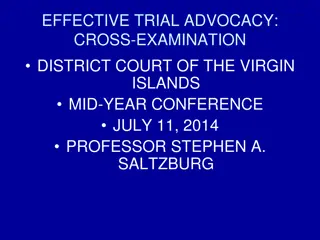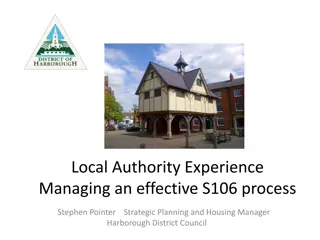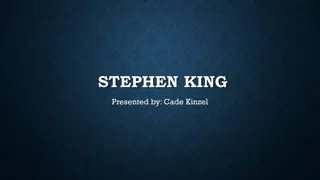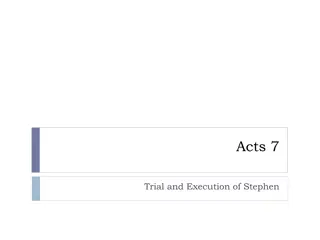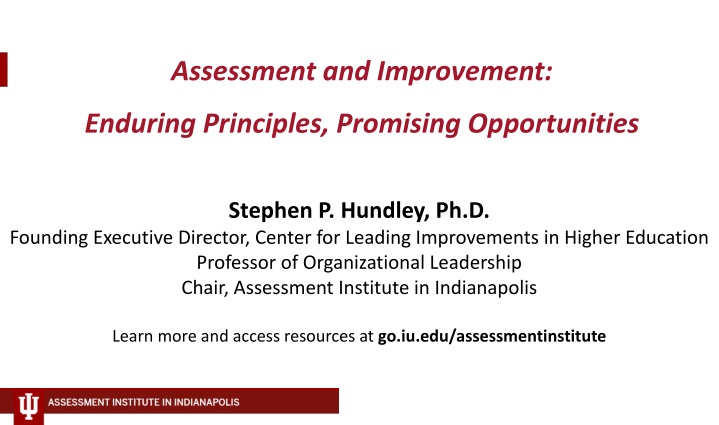
Understanding Assessment and Improvement in Higher Education
Explore the enduring principles and promising opportunities of assessment in higher education, led by Dr. Stephen P. Hundley. Learn about the Assessment Institute in Indianapolis and its resources for promoting a culture of assessment and improvement.
Download Presentation

Please find below an Image/Link to download the presentation.
The content on the website is provided AS IS for your information and personal use only. It may not be sold, licensed, or shared on other websites without obtaining consent from the author. If you encounter any issues during the download, it is possible that the publisher has removed the file from their server.
You are allowed to download the files provided on this website for personal or commercial use, subject to the condition that they are used lawfully. All files are the property of their respective owners.
The content on the website is provided AS IS for your information and personal use only. It may not be sold, licensed, or shared on other websites without obtaining consent from the author.
E N D
Presentation Transcript
Assessment and Improvement: Enduring Principles, Promising Opportunities Stephen P. Hundley, Ph.D. Founding Executive Director, Center for Leading Improvements in Higher Education Professor of Organizational Leadership Chair, Assessment Institute in Indianapolis Learn more and access resources at go.iu.edu/assessmentinstitute IUPUI
About Stephen Professor of Organizational Leadership Serve as Founding Executive Director of the Center for Leading Improvements in Higher Education: Chair of the Assessment Institute in Indianapolis Chair of the International Conference on Assessing Quality in Higher Education Editor of Assessment Update Series Editor of the Assessment and Improvement book series Host of Leading Improvements in Higher Education podcast Held various leadership roles in higher education IUPUI
Learning Goals for Our Time Together Upon conclusion of this session, you should be able to: Explain the importance of assessment and its significance to higher education Identify some enduring principles related to assessment Describe some promising opportunities for assessment Promote a culture of assessment and improvement in your context Use resources from the Assessment Institute in Indianapolis and elsewhere IUPUI
About the Assessment Institute in Indianapolis Oldest and largest U.S. event focused on assessment and improvement International Conference on Assessing Quality in Higher Education Assessment Update, a bimonthly periodical with Wiley Assessment and Improvement Book Series with Routledge/Taylor & Francis Leading Improvements in Higher Education podcast Free Webinar Series offered from throughout the year via Zoom Partnerships with several national associations and research organizations Resources at go.iu.edu/assessmentinstitute IUPUI
Reflection and Sharing Reflection: What is assessment and why is it important? What is an example of how is assessment used in your context? Sharing: In chat, please briefly report on your assessment definition and example May we have a couple volunteers to give a brief oral report for the group? IUPUI
Definition and Purpose of Assessment Systematic analysis of credible evidence involving: Resources (faculty, staff, students, facilities, budgets, etc.) Processes (curriculum, teaching, technology, services, etc.) Outcomes (learning, quality, institutional effectiveness, etc.) To improve: Institutions Divisions and Departments Programs Courses Co-Curricular and Community Activities Assignments Services, Experiences, and Operations in Higher Education IUPUI
Watchwords for Higher Education in 2025 Relevance Evidence Perseverance IUPUI
Introduction: Promoting a Culture of Relevance, Evidence, and Perseverance Planning, Goal Setting, and Resourcing Culture of: Relevance Making Improvements Implementing Interventions Evidence Perseverance Assessing and Evaluating IUPUI
Promoting a Culture of Relevance, Evidence, and Perseverance Planning, Goal Setting, and Resourcing Culture of: Relevance Making Improvements Implementing Interventions Evidence Perseverance Assessing and Evaluating IUPUI
Planning, Goal Setting, and Resourcing What do we want to accomplish, and how will we use resources in doing so? Mission, vision, and values statements Strategic plans Yearly and monthly priorities Feedback from leaders/stakeholders and assessment findings/improvements Resources: human, fiscal, physical, technological, informational, etc. IUPUI
Reflection and Sharing Reflection: What is an example of a plan or goal you have you in your specific context? What resources are you using to ensure the plan/goal is primed for success? Sharing: In chat, please briefly report your plans, goals, and resources May we have a couple volunteers to give a brief oral report for the group? IUPUI
Promoting a Culture of Relevance, Evidence, and Perseverance Planning, Goal Setting, and Resourcing Culture of: Relevance Making Improvements Implementing Interventions Evidence Perseverance Assessing and Evaluating IUPUI
Implementing Interventions What specific strategies, actions, or approaches will we use to accomplish our plans and goals, all while effectively stewarding our resources? Interventions can come from: Assessment findings and other internal information sources Colleagues and subject matter experts locally Promising practices from disciplinary and professional venues Benchmarking with peers and aspirants Literature reviews Network of peers Personal opinions, experiences, and observations alone are typically insufficient to implement an intervention; need to consult a variety of sources IUPUI
Reflection and Sharing Reflection: What is an example of an intervention you have you in your specific context? What source did you consult in deciding upon this intervention? Sharing: In chat, please briefly report your intervention and source May we have a couple volunteers to give a brief oral report for the group? IUPUI
Promoting a Culture of Relevance, Evidence, and Perseverance Planning, Goal Setting, and Resourcing Culture of: Relevance Making Improvements Implementing Interventions Evidence Perseverance Assessing and Evaluating IUPUI
Assessing and Evaluating Progress and Outcomes How well are the interventions we selected helping us achieve our plans and goals, and what evidence are we using to make these determinations? Assessment= taking stock and Evaluation= making judgements Progress= formative and Outcomes= summative Assessment tends to focus on: Understanding strengths and weaknesses to identify trends over time Collaborating with others across the institution Applying professional judgement to evaluate findings and plan actions Using relevant measures aligned to goals and employing a blend of direct and indirect evidence and quantitative and qualitative sources IUPUI
Reflection and Sharing Reflection: What is an example of how you assessed and evaluated the intervention? What evidence did you use in determining the intervention s effectiveness? Sharing: In chat, please briefly report how you assessed and evaluated using evidence May we have a couple volunteers to give a brief oral report for the group? IUPUI
Promoting a Culture of Relevance, Evidence, and Perseverance Planning, Goal Setting, and Resourcing Culture of: Relevance Making Improvements Implementing Interventions Evidence Perseverance Assessing and Evaluating IUPUI
Making Improvements Based on our assessment findings, what actions will we take to improve our specific context, including reporting on our assessment/improvement processes? Involves: Maintaining what is working well Improving where warranted Potentially scaling plans, goals, and interventions to other contexts Uses results of improvement to inform subsequent planning, goal setting, and resourcing activities (a recursive cycle) Requires reporting to internal constituents and demonstrating accountability to external stakeholders (use 4 Key Questions on next slide) IUPUI
Reporting Assessment Outcomes: 4 Key Questions 1. What did you do? (process) 2. What did you learn from it? (assessment results) 3. What changes did you make because of your findings? (improvement) 4. What were the results of those changes? (closing the loop) IUPUI
Reflection and Sharing Reflection: What is an example of how you improved based on assessment findings? In what ways have you reported your assessment/improvement processes? Sharing: In chat, please briefly report how you improved and reported May we have a couple volunteers to give a brief oral report for the group? IUPUI
Summary: Promoting a Culture of Relevance, Evidence, and Perseverance Planning, Goal Setting, and Resourcing Culture of: Relevance Making Improvements Implementing Interventions Evidence Perseverance Assessing and Evaluating IUPUI
Overview of Change Management s Role in Improvement: 8 Considerations 1. Context 2. Category 3. Capacity 4. Connections 5. Concerns 6. Communication 7. Coordination 8. Consequences IUPUI
1. Context Involves identifying the unit of analysis for change (system, campus, unit, department, program, course, or experience), along with recognizing the mission, vison, values, strategic plans and priorities, and culture within that unit of analysis. IUPUI
2. Category Refers to the type of change that is needed (incremental or transformational) and the drivers of that change (internal or external; responsive or opportunistic). IUPUI
3. Capacity Determines the readiness for and willingness of stakeholders to embrace the needed change, including the necessary interventions to develop or implement to support the change. IUPUI
4. Connections Recognizes how the change relates to prior activities and current initiatives, including implications for such items as policies and procedures, operating principles or processes, and resource (re)allocations or incentives. IUPUI
5. Concerns Documents the likely sources of resistance to the change, including the strategies for facilitating buy-in or approaches to minimizing roadblocks to change. IUPUI
6. Communication Outlines the various strategies necessary to inform stakeholders of the need for change, engage them in the change management process, and update them on progress and outcomes associated with the change. IUPUI
7. Coordination Leverages the people, processes, technologies, and other logistics involved in facilitating the change, including the project management approaches to initiate, sustain, and, in some instances, scale the change. IUPUI
8. Consequences Indicates the likely outcomes of realizing the intended change, and, conversely, the implications for not undertaking the change effort. IUPUI
Summary of Change Management s Role in Improvement: 8 Considerations 1. Context 2. Category 3. Capacity 4. Connections 5. Concerns 6. Communication 7. Coordination 8. Consequences IUPUI
Reflection and Sharing Reflection: What is an example of change management in your context? What worked well, and where were there opportunities for improvement? Sharing: In chat, please briefly report on your change management process May we have a couple volunteers to give a brief oral report for the group? IUPUI
To Conclude: Encouraging a Distributed Leadership Approach Various people and contexts are involved in assessment and improvement Specialized knowledge and professional/disciplinary expertise abounds Need for a distributed leadership approach to our work: Vests approaches to and decisions about assessment and improvement in individuals and groups throughout the institution Uses collaborative, inclusive, and democratic processes Shares responsibility and authority for this work Engages with stakeholders throughout the collegiate enterprise IUPUI
To Conclude: Encouraging a Distributed Leadership Approach We can support a distributed leadership approach by: Leading by example to those in our spheres-of-influence Building a coalition of the willing Investing in ongoing professional development Recognizing and celebrating successes early and often Promoting a culture of relevance, evidence, and perseverance IUPUI
Action Planning and Q &A / Discussion In thinking about your work and considering our time together today please reflect on these questions: What is working well in your assessment and improvement endeavors? Where are improvements needed? What will you start, stop, continue, or consider doing? Q&A / Discussion IUPUI

